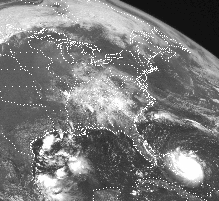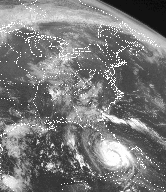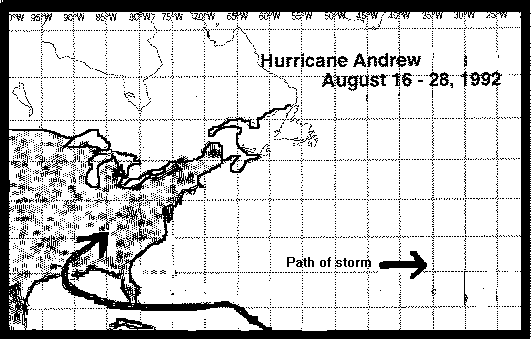




National Disaster Survey Report: (see endnote #12).
1.
The National Weather Service needed to staff the Warning Service
Forecast Office in Miami with a Warning Coordination Meterologist as soon as
possible to enhance the hurricane preparedness program in South Florida.
The NWS should also adopt a plan to increase the number of forecasters capable
of acting as hurricane specialists during emergencies.
2.
It was found that there was a need for better protected, self contained
facilities for the National Hurricane Center and all National Weather Service
offices, especially at critical National Centers where full backup procedures
are difficult to implement.
3.
It was determined that there needed to be more emphasis on building
preparedness and awareness efforts by both state and local emergency
management, especially in areas determined to have high vulnerability. It was
also noted that safety and preparedness materials were in short supply.
Therefore, NOAA and the Dept. of Commerce were encouraged to increase their
support for developing, printing and the distributing of preparedness
materials. FEMA and the National Weather service was also encouraged to
increase the number of annual workshops to train coastal emergency management
officials.
4.
Since lead times for evacuation may not be more than 24 hours, it was
found that it "may not be practical or even possible to evacuate all inland
residents. Therefore, planners need to develop a "refuge of last resort
methodology, as appropriate, for occasions when critical saturation points
are reached in the flow of evacuation traffic." A proven orderly plan needed
to be developed for the safe and timely evacuation of entire metropolitian
areas which take into consideration regional complications which can
compromise orderly evacuation.
5.
The National Meterological Center was found to need to formulate plans
for the intensive interactions with the media that are required when hurricane
s threaten the US coastline. Television meterologists are to be encouraged
in their involvement in the encouraging of evacuation from threated areas.
Media in general should be encouraged to be pro-active and weather conscious
in order to promote an essential link with the public to convey important
information, and Emergency Broadcast System reports. Efforts should be made
to include key radio as well as television providers, including non-english
speaking stations. For example, it was noted that WQBA, the primary EBS
station for Latin American residents in Miami, did not activate EBS during
Hurricane Andrew, making an arbitrary decision that as the hurricane threat
was "already well known" there was no need to activate (see endnote #13).
6.
There needed to be better education of coastal emergency managers to
teach them about the scientific reasoning behind the designation of hurricane
watch and warning areas. In addition there needed to be better communication
between the National Hurricane Center and emergency management in regards to
watch and warning designation. Emergency managers also needed to be taught
how to use all tools available to them in their decision making processes,
including PC-based software specifically designed for that purpose. Specific
programs include, a commercially available program entitled "Enhanced Graphic
Decision System (GDS), which helps users account for forecast uncertainties,
and HURREVAC, which performs basic calculations and features an atlas of map
screen displaying possible areas which could be flooded in various storm
scenarios (see endnote #14).
7.
The National Hurricane Center, National Meterological Center and the
Hurricane Research Division were found to need to develop better models and
operational techniques to forcast tropical cyclonic intensity changes.
Currently the National Hurricane Center's forecast operations have (7)
numerical models for track prediction which include" both statistical and
dynamic types with some incorporating both concepts in their design."
The NHC depends largely on the use of these model outputs, but it is "always
the forecaster's judgement and experience that ultimately determines NHC's
official track forecast." But unfortunately there is only one operational
model that is specifically used to predict the rate of strengthening, the
SHIFOR (Statistical Hurricane Intensity Forecast) model. It was the SHIFOR
model which failed to estimated the true rate of strengthening of Andrew.
Therefore, it is stressed that more models are needed (see endnote #15).
8.
Computers: excessive heat build-up contributed to the failure of the
IBM 4381 mainframe computer at the National Hurricane Center. This computer
drives the McIDAS VDUC, which "injests and displays real-time interactive
satellite, gridded and lightning data." It was found that the National
Weather Service needed to install a stand-alone air conditioning system for
the National Hurricane Center independent of the leased commercial facilities,
to prevent the chance for overheating of critical communications and computer
equipment.
Results from the US Army Corp of Engineers
(USACE) After Action Report:
1.
Under the 1988, Public Law 93-288, amended by Public Law 100-707, and
renamed as "The Robert T. Stafford Disaster Relief and Emergency Assistance
Act (93-288)", the Department of Defense has designated the USACE as the
operating agent "for planning, preparedness, and response under the Emergency
Support Function (ESF) #3, Public Works and Engineering." These tasks include
"technical advice and evaluations, engineering services, construction
management and inspection, emergency contracting, emergency repair of
wastewater and solid waste facilities and real estate support" (see endnote
#16).
2.
There were a total of (80) lessons learned by the USACE with resulting
recommendations. Categories included were: administration; contracts;
Directorate of Military Support (DOMS); emergency management; human resources;
information management; individual mobilization augmentees (IMA); internal
review; logistics management; prime power; construction standards; real estate;
and resourcemanagement.
3.
The commander's assessment stated that "never before has the Federal
government been confronted by a disastrous situation in which it was depended
upon, so heavily, for assistance in saving life and property." The aftermath
of Hurricane Andrew "caused events and responses that will shape and reshape
the way the Federal government responds to major disasters in the future"
(see endnote #17).
4.
Under the administration category , recommendations were made to:
a) create a file of administrative policy issues applicable to disaster
response efforts;
b) standardize forms and have "dummy" examples of those forms to help
automate the forms preparation process;
c) create updated standard organization charts with names and phone
numbers of key personnel;
d) and create standardized in-processing procedures to inform individuals
of current disaster situations (see endnote #18).
5.
Under the category of contracts recommendations were given to:
a) standardize letter contracts as much as possible;
b) letter contracts chould not be a primary contracting tool and should
be used as little as possible;
c) definitization schedules should be established ASAP after or in
conjunction with the award of contracts;
d) modify databases to also include local vendor names, phone numbers,
and 24 hour point of contacts (POC);
e) give preference to local labor contracts;
f) make sure to first to wait until FEMA has determined the direction
disaster relief should take before assigning contractors;
g) there needs to be "an automatic delegation of authority for the
Contracting Officer at the Recovery Office to execute contracts within
pre-determined limits";
h) that FAR 5.303(a) be amended to add an exception which would waive
the Congressional notification requirement during a Presidentially declared
emergency (see endnote #19). t/dt><
6.
Under the category of DOMS the following recommendations were made:
a) that the Director of Military Support messages "which assign the
support command relationships also must identify for the supported commander
the funding source to fulfill requests for Corps of Engineers support;
b) that a coordinated link be created between the Federal Coordinating
Officer (FCO), the Defense Coordinating Officer (DCO) and the Emergency
Support Function (ESF) #3 team at each Disaster Field Office, to cut down on
confusion;
c) that a Federal Response Plan training be developed for military
personnel "to provide instruction on the ESF concepts and the military's
coordination role";
d) that all the military specialty units be identified whose primary
missions relate to ESF functions;
e) that DOMS and FEMA should establish clear policies on the extent of
military involvement in disaster response activities (see endnote #20).
7.
Under the category of Emergency Management these recommendations were
given:
a) that there is a need to identify individuals who are capable and
available for serving on emergency response teams;
b) that there should be made an extensive study on the effectiveness of
mobile command centers;
c) that repeated lessons learned from previous disasters be noted and
utilized in the Corps of Engineers Corrective Action Program;
d) that there is a need for one automated system based on standard,
readily available software, to be adopted for Corps wide use;
e) that there was a need to establish guidelines for the reporting of
data and information, with exact requirements clearly defined, with written
communication used to the "maximum extent possible", with all other
information being transmitted electronically;
f) careful consideration needed to be given as to what information and
at what frequencey the information is really needed at a headquarters level,
with efforts toward the development of standardized reports;
g) that a common reporting program be created that could access other
data bases;
h) that a checklist of "standard" or essential elements of information
requirements be developed that could be responded to in a written format;
i) prior to a storm event have military aircraft standing by,
prepositioned outside the storm area, "with sufficient personnel to perform
aerial reconnaissance as soon as weather conditions permit";
j) there needs to be a field manual created that will outline the basic
steps in responding to specific kinds of disasters;
k) for each activity performed toward disaster relief, a Disaster Mission
Folder should be made with a checklist of all required actions
(chronologically) listed necessary to the completion of each task;
i) that a matrix needed to be developed that showed all the support
agencies, their available manpower, and the various skills and/or equipment
that can be provided for response/recovery operations (see endnote #21).
8. Under the category of Human Resources the following recommendations
were made:
a) that it was necessary to develop a "comprehensive education, training
and exercise program to be implemented throughout the Corps at all levels to
provide personnel with the appropriate information and latest changes in
established guidance, policies and procedures for disaster response under the
Federal Response Plan (FRP)";
b) that it was recommended that theResponse Planning Group establish a
centralized database which would be equally accessible to all offices
concerned (see endnote #22).
9) Under the catagory of Information Management, these recommendations
were made:
a) have a GIS software package and knowledgeable users on hand, as well
as spacial data bases for major metropolitan areas available for downloading
at disaster sites;
b) place emphasis on the standardization of compatible, easily integrated
software, as well as develop a standardized Emergency Management Office Data
Base Management System - systems should contain standardized hardware,
software and local area network connections - there should be a standardized
GIS system, used by all response agencies, for maintaining day to day
evaluations of progress.
c) make sure alternative methods of communication are provided to the
organizations involved in response actions (see endnote #23).

In sum, it appears that the overall lessons learned through the Hurricane
Andrew experience had to do most with a need for better overall communication
between governmental offices, the Army Corp of Engineers, emergency management
planners in the state and local levels, and a need for increased dissemination
of information to the public. Emergency management policies and
infrastructures had simply not been fully tested and proven prior to the
disaster showing a lack of overall readiness. Computer enhanced communication
systems were either insufficient, lacking backup systems, or non exhistent.
Policies for public training programs and dissemination of published emergency
information materials were insufficient based on the needs of the population.
Such similar problems would also be encountered by governmental agencies in
the following year, which we will examine in our last case of the "Great
Flood of 1993."

Footnotes for Case #3:
1.
Ruth Gastel, "Catastrophes: Insurance Issues" Insurance Information Institute Reports
(Insurance Information Institute, February 1994)
2.
"A.M. Best releases Hurricane Andrew Survey Results"
Financial News(PR Newswire Assoc. Inc., 12/14/92)
3.
Ruth Gastel, "Catastrophes: Insurance Issues" February 1994
4.
Richard Korman, "Natural Disasters: Andrew exposes safety gaps"
ENR: The McGraw-Hill Construction Weekly vol.229 no.10
(New York: McGraw Hill, 9/7/92) p.8
5.
Ann Lindstrom, "Potential for Disasters keep telcos alert: Be Prepared!"
TELEPHONY vol.223 no. 13 (Kansas : Intertec Publishing Corp., 9/28/92)
p.17
6.
Donald E. Fink, "Storm Cripples South U.S. Airline, Military Facilities"
Aviation Week and Space Technology 8/31/92 p. 27
7.
Dr. Forest W. Horton, Jr. and Dr. Dennis Lewis. Great Information
Disasters:
Twelve prime examples of how information mismanagement led to
human misery,
political misfortune and business failure.
(London: Aslib, the Association for
Information Management, 1991) p. 112
8.
Natural Disaster Survey Report - Hurricane Andrew: South Florida and
Louisiana August 23-26, 1992
(US Dept. of Commerce/National Oceanic and
Atmospheric Administration [NOAA], November 1993) p. xvi
9.
GAO/T-RCED-93-4 "Disaster Management: Recent Disasters Demonstrate
the Need
to Improve the Nation's Response Strategy" United States
Accounting Office Testimony
Before the Subcomittee on VA, HUD and
Independent Agencies, Committee on Appropriations,
U.S. Senate. 1/27/93 p.1
10.
GAO/T-RCED-93-4 p. 3
11.
GAO/T-RCED-93-4 pp.4-5
12.
Natural Disaster Survey Report - Hurricane Andrew. pp. xvii-xxviii
13.
Natural Disaster Survey Report - Hurricane Andrew. p. 65
14.
Natural Disaster Survey Report - Hurricane Andrew. p. 37
15.
Natural Disaster Survey Report - Hurricane Andrew. p. 51
16.
"US Army Corps of Engineers: Headquarters USACE After Action Report
for Hurricanes Andrew and Iniki "
(USACE Directorate of Civil Works
Operations, Construction and Readiness Division Readiness Branch,
May 1993) p.1
17.
"USACE After Action Report for Hurricanes Andrew and Iniki" p.12
18.
"USACE After Action Report for Hurricanes Andrew and Iniki"
pp.17-19
19.
"USACE After Action Report for Hurricanes Andrew and Iniki"
pp.20-30
20.
"USACE After Action Report for Hurricanes Andrew and Iniki"
pp. 31-35
21.
"USACE After Action Report for Hurricanes Andrew and Iniki"
pp.35-84
22.
"USACE After Action Report for Hurricanes Andrew and Iniki"
pp.85-89
23.
"USACE After Action Report for Hurricanes Andrew and Iniki" pp.90-95

(Updated 9/0/03 D.J. Russell)



Go to
*LOOKING AT FOUR RECENT DISASTERS* - Case #4!

Return to *LOOKING AT FOUR RECENT DISASTERS - Table of Contents!

Send comments to DJ!

Back to DJ's home page!
Under the administration category , recommendations were made to:
Under the category of contracts recommendations were given to:
Under the category of DOMS the following recommendations were made:
Under the category of Emergency Management these recommendations were given:
In sum, it appears that the overall lessons learned through the Hurricane Andrew experience had to do most with a need for better overall communication between governmental offices, the Army Corp of Engineers, emergency management planners in the state and local levels, and a need for increased dissemination of information to the public. Emergency management policies and infrastructures had simply not been fully tested and proven prior to the disaster showing a lack of overall readiness. Computer enhanced communication systems were either insufficient, lacking backup systems, or non exhistent. Policies for public training programs and dissemination of published emergency information materials were insufficient based on the needs of the population. Such similar problems would also be encountered by governmental agencies in the following year, which we will examine in our last case of the "Great Flood of 1993."
Footnotes for Case #3:
1.
Ruth Gastel, "Catastrophes: Insurance Issues" Insurance Information Institute Reports
(Insurance Information Institute, February 1994)
2.
"A.M. Best releases Hurricane Andrew Survey Results"
Financial News(PR Newswire Assoc. Inc., 12/14/92)
3.
Ruth Gastel, "Catastrophes: Insurance Issues" February 1994
4.
Richard Korman, "Natural Disasters: Andrew exposes safety gaps"
ENR: The McGraw-Hill Construction Weekly vol.229 no.10
(New York: McGraw Hill, 9/7/92) p.8
5.
Ann Lindstrom, "Potential for Disasters keep telcos alert: Be Prepared!"
TELEPHONY vol.223 no. 13 (Kansas : Intertec Publishing Corp., 9/28/92)
p.17
6.
Donald E. Fink, "Storm Cripples South U.S. Airline, Military Facilities"
Aviation Week and Space Technology 8/31/92 p. 27
7.
Dr. Forest W. Horton, Jr. and Dr. Dennis Lewis. Great Information
Disasters:
Twelve prime examples of how information mismanagement led to
human misery,
political misfortune and business failure.
(London: Aslib, the Association for
Information Management, 1991) p. 112
8.
Natural Disaster Survey Report - Hurricane Andrew: South Florida and
Louisiana August 23-26, 1992
(US Dept. of Commerce/National Oceanic and
Atmospheric Administration [NOAA], November 1993) p. xvi
9.
GAO/T-RCED-93-4 "Disaster Management: Recent Disasters Demonstrate
the Need
to Improve the Nation's Response Strategy" United States
Accounting Office Testimony
Before the Subcomittee on VA, HUD and
Independent Agencies, Committee on Appropriations,
U.S. Senate. 1/27/93 p.1
10.
GAO/T-RCED-93-4 p. 3
11.
GAO/T-RCED-93-4 pp.4-5
12.
Natural Disaster Survey Report - Hurricane Andrew. pp. xvii-xxviii
13.
Natural Disaster Survey Report - Hurricane Andrew. p. 65
14.
Natural Disaster Survey Report - Hurricane Andrew. p. 37
15.
Natural Disaster Survey Report - Hurricane Andrew. p. 51
16.
"US Army Corps of Engineers: Headquarters USACE After Action Report
for Hurricanes Andrew and Iniki "
(USACE Directorate of Civil Works
Operations, Construction and Readiness Division Readiness Branch,
May 1993) p.1
17.
"USACE After Action Report for Hurricanes Andrew and Iniki" p.12
18.
"USACE After Action Report for Hurricanes Andrew and Iniki"
pp.17-19
19.
"USACE After Action Report for Hurricanes Andrew and Iniki"
pp.20-30
20.
"USACE After Action Report for Hurricanes Andrew and Iniki"
pp. 31-35
21.
"USACE After Action Report for Hurricanes Andrew and Iniki"
pp.35-84
22.
"USACE After Action Report for Hurricanes Andrew and Iniki"
pp.85-89
23.
"USACE After Action Report for Hurricanes Andrew and Iniki" pp.90-95
(Updated 9/0/03 D.J. Russell)
